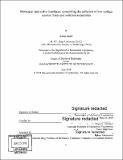Molecular and active interfaces : controlling the adhesion of low surface tension fluids and solid microparticles
Author(s)
Khalil, Karim S. (Karim Samir)
DownloadFull printable version (9.249Mb)
Other Contributors
Massachusetts Institute of Technology. Department of Mechanical Engineering.
Advisor
Kripa K. Varanasi.
Terms of use
Metadata
Show full item recordAbstract
ABSTRACT This thesis will investigate several approaches that utilize interfacial engineering to control the wetting of low surface tension liquids and adhesion of solid microparticles on surfaces. While approaches to repel and control water are studied abundantly in the literature, we focus on low surface tension liquids that readily spread on most substrates, and solid microparticles. Significant attention over the last 50 years has been devoted to the enhanced condensation of steam. Beyond water, there are several other industrial condensation processes including HVAC, LNG storage, and organic Rankine cycles, where enhancing condensation heat transfer would be greatly beneficial. However, far fewer studies have been devoted to finding methods of enhancing condensation of low surface tension fluids, which are condensed in these processes. Our group has demonstrated that Lubricant Impregnated Surfaces could be used to promote dropwise condensation of these fluids and thereby increase the condensation heat transfer coefficient. Yet there remain limitations with the durability and relatively high thermal resistance of these coatings, issues which could be addressed by replenishing drained lubricant and using ultra-thin films. Based on these findings, in this thesis we use initiated chemical vapor deposition (iCVD) to graft ultra-thin low-energy polymer surfaces that can stably promote dropwise condensation of low surface tension fluids. Adhesion of dust particles to surfaces is a natural phenomenon that imposes widespread challenges in many industrial processes including solar concentration and solar PV, where reflectivity and transmissivity are vital to overall efficiency. Prior studies in this area have focused on minimizing particle-surface adhesion via modifying the surface energy of the substrate. Using an atomic force microscope affixed with a colloidal particle, we have conducted adhesion measurements on a variety of textured surfaces. Our results show that the nanoscale contact area's effective radius of curvature is the relevant length scale to the magnitude of the adhesion force. By engineering the contact geometry at the nanoscale, we are able to show a reduction of adhesion by two orders of magnitude. Lastly, active fields are used to enhance the condensation of ultra-low surface tension fluids and control the uniformity of microparticle deposition patterns during colloidal droplet evaporation. Acoustic waves are utilized to enhance the condensation of ultra-low surface tension liquids, and electric fields are used to suppress the coffee-ring effect and ultimately control the uniformity of microparticle deposition during droplet evaporation.
Description
Thesis: Ph. D., Massachusetts Institute of Technology, Department of Mechanical Engineering, 2018. Cataloged from PDF version of thesis. Includes bibliographical references (pages 77-85).
Date issued
2018Department
Massachusetts Institute of Technology. Department of Mechanical EngineeringPublisher
Massachusetts Institute of Technology
Keywords
Mechanical Engineering.